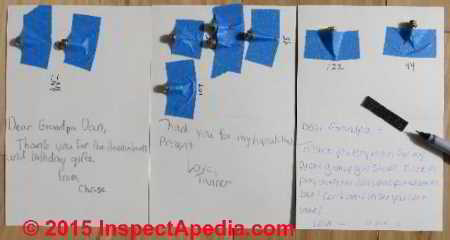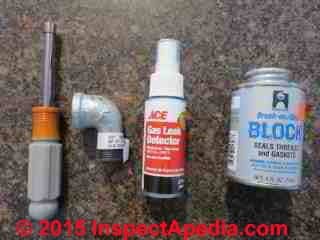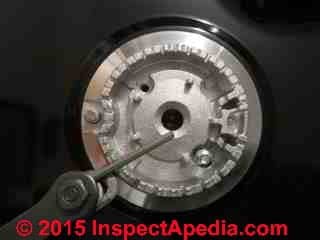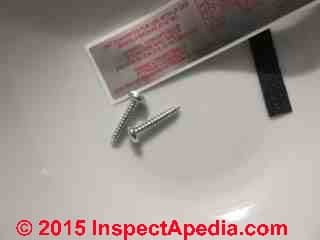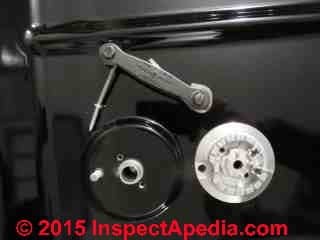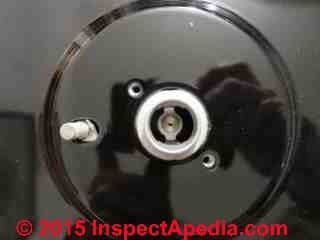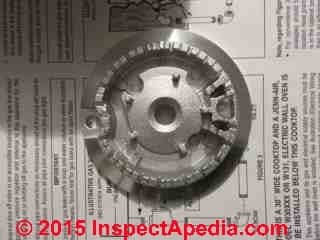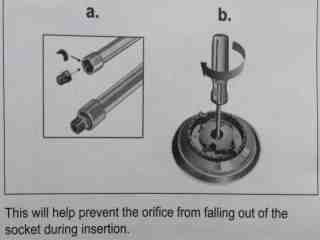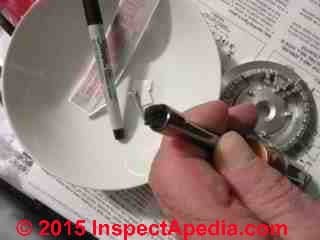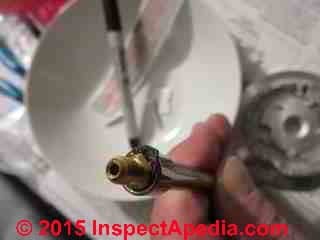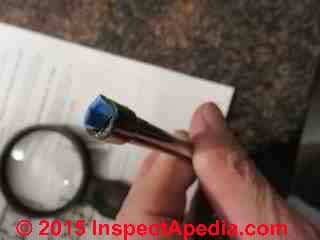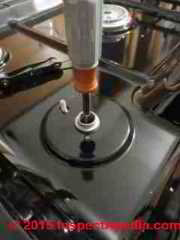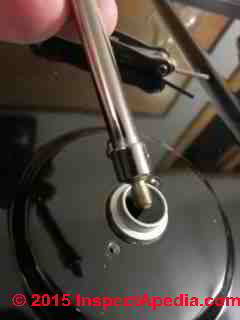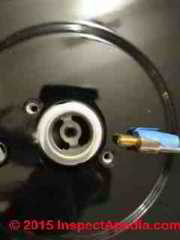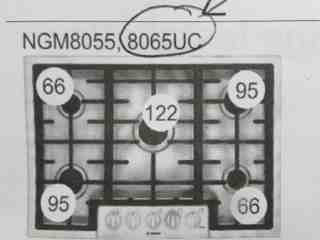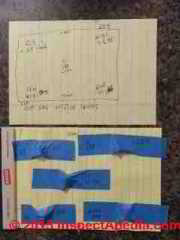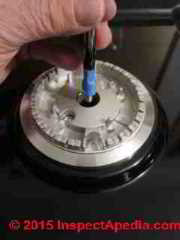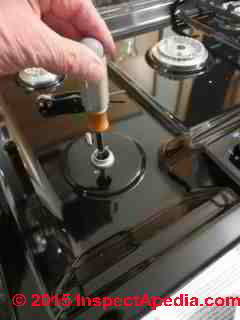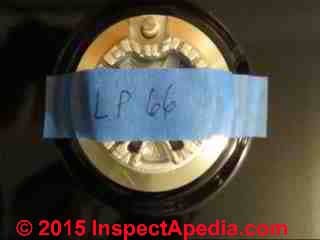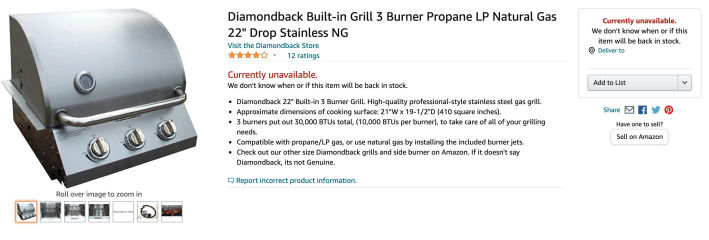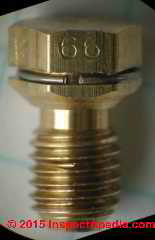
 How to Convert Gas Appliance Spuds or Orifices from LP to Natural Gas or from Natural Gas to Propane
How to Convert Gas Appliance Spuds or Orifices from LP to Natural Gas or from Natural Gas to Propane
- POST a QUESTION or COMMENT about gas fuel conversions: LP or "bottled gas" to piped-in natural gas service
LP to Natural Gas appliance orifice or spud conversions or Natural Gas to LP fuel conversion procedures.
How to remove the old and install the new properly-sized gas metering orifices or "gas spuds" at a gas fired appliance when converting between natural gas and propane or LPG.
This article series explains the procedure for converting from LP gas or "bottled gas" to natural gas or "piped in gas" at a building.
Watch out: gas appliance adjustments are needed not just when changing between LP or propane and natural gas but also at high altitudes. When using a natural gas or propane-burning appliance of any type (e.g. gas range, gas water heater, gas furnace, gas incinerator toilet) at higher altitudes, adjustments to the gas burner's metering orifices, regulator, combustion air, and even venting will usually be needed for safe use.
InspectAPedia tolerates no conflicts of interest. We have no relationship with advertisers, products, or services discussed at this website.
- Daniel Friedman, Publisher/Editor/Author - See WHO ARE WE?
How to Change the Gas Orifices (Spuds) at Cooktop Burners to Convert between Natural Gas & LP Gas - Example
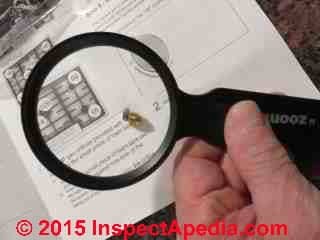 Watch out: Most manufacturers require that installation and fuel conversions shall be performed by a trained and qualified service technician. The technician should be sure to correctly identify the model number of your gas appliance so that s/he can follow the correct details of the manufacturer's instructions.
Watch out: Most manufacturers require that installation and fuel conversions shall be performed by a trained and qualified service technician. The technician should be sure to correctly identify the model number of your gas appliance so that s/he can follow the correct details of the manufacturer's instructions.
[Click to enlarge any image]
For most gas cooktops a threaded brass orifice or "spud" is used to meter gas at the proper flow rate at each burner. Gas flow rate, a combination of supply pressure and orifice diameter, determines the quantity of gas available at the individual burner and thus sets its BTU output rate or range.
The orifice diameter of these tiny little parts is different between natural gas and propane or LP gas. This means that you will need to change the orifice fittings to match the fuel you intend to use.
When converting an appliance from using a lower pressure natural gas fuel supply to a higher pressure LP or propane gas fuel supply, the new orifices will be smaller in diameter to accommodate the higher pressure of the fuel supply without releasing too much fuel too quickly.
Watch out: Converting a gas appliance is dangerous if not done correctly and in accordance with the manufacturer's instructions. Here are two typical manufacturer's gas conversion kit warning notices
This conversion kit shall be installed by a qualified service agency in accordance with the manufacturer’s instructions and all applicable codes and requirements of the authority having jurisdiction.
If the information in these instructions is not followed exactly, a fire, explosion, or production of carbon monoxide may result, causing property damage, personal injury, or loss of life.
The qualified service agency is responsible for the proper installation of this kit.
The installation is not proper and complete until the operation of the converted appliance is checked as specified in the manufacturer’s instructions supplied with the kit. - Whirlpool corporation citation below
This conversion kit must be installed by a qualified installer or service technician in accordance with these instructions.
Installation must conform with local codes, or in their absence, with the latest edition of the National Fuel Gas Code, ANSI Z223.1.
Failure to follow instructions could result in serious injury or property damage. The qualified agency performing this work assumes responsibility for this conversion. - Rheem conversion instructions - Natural Gas to LP Gas, citation below
What do the Numbers Mean on Gas Spuds or Orifices?
The number on a gas spud is equivalent to a drill size that also can be expressed in decimal inches and that also translates into a pressure rating in inches of water or a BTU rate in natural gas or LP gas - propane.
Example: a No. 54 gas orifice is equivalent to a 0.055 inches H2O and provides 7680 input btu of natural gas. The BTU rating will be different, of course, for propane.
The example data below is excepted from Anderson & Forrester's more-complete gas orifice conversion chart cited below.
Gas Spud Size |
LPG | Natural Gas | |||
Gas Pressure as In. H2O: |
11 | 3 | 3.5 | 7 | |
| Drill Size | Decimal Inches |
BTU | BTU | BTU | BTU |
| 122 | |||||
| 95 | |||||
| 80 | 0.0135 | 1237 | 428 | 463 | 654 |
| 70 | 0.028 | 5476 | 1843 | 1991 | 2815 |
| 66 | 0.033 | 7607 | 2560 | 2765 | 4745 |
| 44 | 0.086 | 51663 | 17385 | 18778 | 26557 |
Notes to the table above
Sources: excerpted from a more complete table provided by
- GAS SPUD Orifice Conversion Chart - Drill Size - Inches - BTU Rate at Various Pressures in Inches of H2O [PDF] Anderson Forrester, 716 N. Commercial Street, Clearwater, KS 67026 USA, Web: https://andersonforrester.com/ Tel: 800.745.4466 - retrieved 22022/04/26, original source: https://andersonforrester.com/conversion-chart/
Website excerpt: Our focus is to be the “one source” provider for any original equipment manufacturer for their natural gas and propane orifice and conversion fitting needs, and to be the top supplier of replacement parts, gauging drills, broaches, reamers, and special tools in support of the gas service industry.
See this Anderson & Forrester CATALOG of PRODUCTS & SERVICES [PDF] - retrieved 2022/04/26 original source: https://andersonforrester.com/wp-content/uploads/2015/08/AF_Cat_2015_01g_72dpi_RGB.pdf - The Table Uses these Gas Properties:
Natural Gas - 1050 BTU - 0.65 SP.Gr
LP Gas - 2500 BTU - 1.35 SP.Gr
The BTU number is the LP or natural gas use in BTUs per hour vs. orifice size (drill size or wire size). - In the table "Drill size" refers to a gauging drill used to set orifice diameter. Some sources may refer to Wire Number (Wire #) or to a Letter (A-Z) where letters are used for certain sizes (e.g. S = 0.3480 in.). Other drill or wire gauge size tables will be expressed in mm.
- Sinclair, GAS ORIFICE vs BTU CAPACITY CHART [PDF] Sinclair Supply Limited, 10914-120th Street Edmonton, AB T5H 3P7 Canada, Phone/Text: 780-452-3110 Toll Free: 1-800-661-8724 with locations in Edmonton, Calgary, Fort McMurray, Grand Prarie, Lethbridge. Web: ssi.ca - retrieved 2022/04/26 original source: https://ssl.ca/wp-content/themes/sinclair-supply/pdf/Gas-Orifice-Capacity-Chart.pdf
Select the Proper Gas Orifice or Spud According to the Manufacturer's Specifications
Our example Bosch gas cooktop, the same unit whose regulator we converted earlier, came factory-set with orifices installed for natural gas. The manufacturer includes a set of brass orifice fittings (shown below) that must be used when converting the cooktop from natural gas to LP or propane fuel.
A typical gas appliance spud or orifice will be marked with
- A letter: L (for LPG) or N (for natural gas)
- A number: (such as 44 or 122) indicating the orifice opening diameter.
Watch out: it's darn hard to read the tiny numbers and letters stamped onto these parts. You'll want a magnifying glass, or as we used for the photos below, a stereo microscope. It is critical to properly identify the orifice size for each of these otherwise identical-looking parts and to use the correct orifice at each burner.
Why? Because burner sizes vary and must be matched to the orifice. The manufacturer gives a clue for old blind guys like me by putting a dab of colored paint on the orifices (third photo from left):
our #95 had a dab of green paint and our #109 (not shown) had a dab of black. But the paint may be gone or not noticeable.
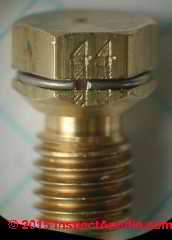 ...
...  ...
...  ...
... 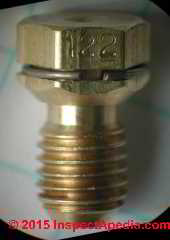
Watch out: don't lose any of these little beggars or your installation will stop dead until you can obtain a replacement from the manufacturer. It's easy to drop one and lose it, including down into the range top. The manufacturer has some suggestions about that that we'll get to soon.
I used the thank-you notes from three of my grandchildren as handy cards to tape down the orifice fittings and to label them for use.
Watch out: because the LP Gas Conversion Kit provided by the manufacturer may be designed to convert several models of their gas appliances, your kit may include more orifice fittings than you will need to use. So pay attention.
Our kit included orifices #44, #66, #109 (not shown), #95, and #122. Of these, for the Bosch Gas Cooktop model we were converting, Bosch NGM8065UC, we needed to use five orifice fittings by removing the installed ones and replacing them with these:
- one #122 (big center burner),
- two #95 orifices the two larger burners at the front left and rear right corners of the cooktop
- two #66 orifices to be installed at the rear left and front right burners of the cook top
The manufacturer recommends that you save the natural gas orifices that you remove in case the cook top ever needs to be converted back from LP gas to natural gas.
We'll show you how to (follow the gas cook top manufacturer's instructions) install the orifice fittings without losing one down into the range top and how to make the other adjustments required to the gas cook top when converting fuel between natural gas and LP gas.
How to Remove Existing & Install New Gas Orifice Spuds in the Gas Cooktop to Change from Natural Gas to Propane (or vice versa)
We bought the gray and orange-handled metric nut driver shown at below right to match the spuds (orifices) of the Bosch gas cooktop being installed for this article series after seeing that our existing (and very close fit) red-handled nut driver(shown at below left) didn't fit into the opening in the gas cooktop burner through which the orifices are to be removed and installed during a gas conversion.
Remove Aluminum Burner Base if Needed to Pass the Nut Driver into the Cooktop
Watch out: Hah! While it was an important improvement to buy a nut driver that fits the spuds, the new nut driver didn't fit into the cooktop burner openings either.
That's why we needed a metric hex key set - to remove the machined aluminum burner base to provide a larger access opening to retrieve the installed gas orifice and to install the new orifice needed when changing from the factory natural gas set-up to a propane set-up.
Use the hex key, working with care not to strip the insert opening in the screw tops, and remove the two sheet metal screws holding the burner base in place on the cooktop surface. Put the screws into a bowl or other container since if you lose them you'll be making another trip to the hardware store.
At below left you can see my metric hex key, the sheet metal screw, and the gas burner base after it was removed. I took care not to drop any shards of aluminum or any other crud down into the cooktop opening.
Set the gas burner base aside (below left) and enjoy peering down into the now-exposed and sufficiently-large opening where you can see the existing gas metering spud or orifice in the cooktop (above right). Below is the gas burner base set aside.
Prepare the Nut Driver to Avoid Dropping Orifice Spuds Into the Cooktop
Watch out: don't event think of inserting your nut driver into this opening to remove the existing orifice before reading the manufacturer's warning about dropping that little orifice part into the cooktop body.
You'll have a hell of a time retrieving the orifice spud if you lose one down inside the cooktop body. The gas cooktop body is typically sealed by the factory and is not designed to be opened without damage. Picture yourself lying on the floor holding the cooktop overhead and shaking it around to try to get the little spud to fall out of the little opening you see above.
Manufacturers suggest using a piece of thin foam (provided kindly by Bosch) or some reversed masking tape (provided by you) inside the nut driver to make it fit snugly over the orifice - spud so that you can safely unscrew the installed orifice and lift it carefully out through the opening in the burner top without dropping it inside. (Photo below left).
Test the snugness of fit of your nut driver onto the orifice spud before trying to unscrew the existing one by fitting your tape or foam-modified nut driver onto a spud to feel that it is firm and to see that you didn't simply push your foam tape or masking tape up inside the nut driver where it does no good. (Photo, above right).
I used the foam tape provided by Bosch but left a lip of tape outside the edge of the nut driver where, bent over, it helped keep the tape from simply collapsing into the nut driver. I also replaced this snugging material as needed as I progressed through the five orifice spuds that needed to be removed and the five that needed to be installed.
If your manufacturer isn't as thoughtful as Bosch who provide thin foam tape to use inside the nut driver, fold a bit of masking tape sticky-side out and insert it into the nut driver as I show above.
Remove the Existing Gas Orifice Spuds From Each Cooktop Burner Opening
Work slowly and carefully with patience - which is better than dropping a spud into the cooktop.
At below right I've angled the nut driver over to show you how nicely it is holding the orifice spud.
But like a New Zealander telling you how long it will take to hike up to the Queen Charlotte track, I'm lying. I only angled the nut driver to make the photo clear.
In actual practice I took great care to lift the nut driver carrying the orifice spud straight up out of the cook top opening when removing this little part.
At below left you can see the threaded opening inside the cooktop from which I've removed the orifice spud - shown secure in the end of my nut driver in the right side of the photo.
Watch out: Take care not to bang the spud against the side of the opening or you may lose it.
Select the Proper Gas Orifice Spud to Install Into Each Cooktop Burner
Now we select the proper new gas orifice (spud) to be screwed into the cook top's burner opening from which the old one was removed.
In this case we were removing natural gas-sized orifices and installing LP gas-sized orifices that were provided by the manufacturer and were included in the cook top's packaging.
Watch out: since there are two or three different gas burner sizes on the cook top (depending on model) you need to take care to choose the proper orifice spud size when installing each of these into their respective burners. The manufacturer's instructions will tell you which orifice size goes where. Getting this wrong can be dangerous so stop kneeling on the instructions and read them.
Your gas cook top may come with all of the orifices needed to change between LP and Natural Gas fuels and may include some orifice spuds that you do not need to use since it's cheaper to simply send along a standardized conversion package that fits several appliances.
Save the Old Gas Orifices & Install the New Gas Orifice Spuds into the Cooktop
Tip: Below I've sketched out and kept notes on not only the new burner LP gas orifices that were installed, but the size of each natural gas orifices that I removed and which burner they came from. This would allow the (unlikely) re-conversion of this gas cooktop back to natural gas should the need arise. Keep the old gas orifices and store them where they might be found if needed.
The only gas burner whose aluminum burner base opening was large enough to allow the nut driver to pass in to remove the old and install the new gas orifice was the large center burner on this gas cooktop (below left). All of the other four gas burners required removal of the aluminum burner base as I described earlier.
Using the same compulsive neurotic care I installed the new gas orifice spud into the burner, keeping the nut driver vertical and lowering it along with the orifice carefully straight down through the cooktop opening to screw it in place.
Re-Install the Burner Base That Was Previously Removed
Below (left) you can see the new orifice successfully installed without having lost it inside the cook top. Hot dog!
I worked one burner at a time, reassembling the burner base and marking it with blue tape as "done" on completion so that after a lunch break I would remember which burners had been converted.
You probably won't bother to do this but consider this: it's nice to cover the burner openings through which you were working to make double sure that during the rest of the gas cooktop installation you don't accidentally drop something into one of these openings.
Gas Technician Describes How to Drill Out Propane Spuds to Convert to Natural Gas
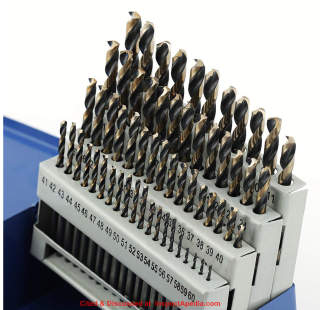 Illustration: a typical numbered drill bit set
Illustration: a typical numbered drill bit set
Watch out: the opinion and experience given by the gas service technician below may not be safe if attempted by an in-experienced or in-expert homeowner or other person.
On 2023-03-29 by Kevin C - experienced service tech drills out propane gas spuds to convert to natural gas
Having worked as a service tech for a natural gas distribution company for 28 years I have found that the easiest and most effective way is when converting from LP to Natural ( if a conversion kit isn’t supplied) is to remove the spuds or orifice from each burner.
Select a drill bit that is close to the same size hole and start trying to find the biggest bit that will fit. That is your drill bit size. Simply go up 8 or sometimes 9 sizes and drill the spud out.
That is going to very very close!! This method works regardless of model number or manufacturer!
Keep in mind you must adjust the regulator from LP (11” Wc) to Natural gas(4-4.5” wc) After you have installed the spud back into the burner, it’s simply a matter of adjusting your air shutter (if applicable) until your flames are pretty and blue and not trying to lift off of your burner!
A tiny white tip on the end of the flame is perfectly fine! What you don’t want is a bright white flame!!! I guarantee you this method works if done correctly!! It’s not rocket science. I have converted 1000’s of appliances over my career and I wouldn’t be typing this if it wasn’t safe and effective!
If converting from natural to LP then you have to replace the spuds since the orifice or hole size is smaller for LP! The reason the hole is smaller is because…. 1- LP has 3 times a many BTUS per cubic ft . 2- LP is heavier and therefore has to be pushed at a higher pressure as natural gas!
Watch out: One thing to note! If you are using a conversion table make absolutely sure to use the 4” wc column because most appliances like ranges,heaters,water heaters all have a regulator either separate from or built into the control valve reducing pressure from 6-7”wc down to usually 4”wc. (WC= water column) .
On 2023-03-29 by InspectApedia Editor - Drilling Out Propane Gas Spud Orifices to Switch to Natural Gas?
@Kevin C,
Thank you, that's an interesting and credible report of a do-it-yourself LP - TO - Natural gas conversion idea.
Drilling out an LP orifice (spud) to a larger size, PROVIDED the do-it-yourselfer actually can find the correct size drill bit, is credible.
In fact we give some gas spud orifices as drill sizes as well as in inch fractions in a table above on this page.
You also were good to mention other burner adjustments that are needed.
For readers to understand your suggestion, you need to define "drill bit size" when you say go up 8 or 9 sizes. Sizes of what: inches, mm, wire size, or something else?
Examples of types of drill bit kits by different size metrics such as wire gauge, fractional sizes, letter sizes, from drill bits sold by the Pan American Tool Corporation - web: panamericantool.com
---
Some warnings for our readers and some explanation follow.
Comparison of BTUs Provided by Natural Gas vs Propane if the Spud Orifice Remains Un-Changed
Above on this page, we provide an explanation of gas fueled equipment spud orifice sizes.
Gas appliance spud orifice size numbers are expressed in decimal inches, or hundredths of an inch.
The gas spud orifice size results in a specific gas flow rate or BTUh rating - BTUs of energy consumer per hour.
Through the same spud orifice size, the the BTU rate per hour would be much less burning natural gas than LP gas.
That's because
- The operating pressure of natural gas is less than propane
- The number of BTUs in a cubic foot of natural gas is less than half the number of BTUs in a cubic foot of propane
LP gas operates at a higher pressure and is also more dense than natural gas.
At GAS BTUH, CUBIC FEET & ENERGY we have
- One cubic foot (0.028 cubic meters) of propane contains about 2,516 BTUs
- One cubic foot (0.028 cubic meters) of natural gas contains about 1,050 BTUs or 1,037 BTUs (US EIA)
So you can see why converting from propane to natural gas, the spud orifice is going to get bigger.
Look at the two example gas spud orifice sizes shown at the top of this page.
These were for the same burner on the same gas appliance, converting between natural gas (95 stamped into the spud) and propane (66 stamped into the spud).
What do those numbers on the gas spud mean?
The spud stamped 95 means that the orifice in the spud is approximately 0.095 inches in diameter.
The spud stamped 66 means that spud orifice is 0.066 inches in diameter.
If the manufacturer's gas spud conversion kit for a specific burner going FROM propane (the smaller orifice) TO natural gas (the larger opening) the increase was
0.095 - 0.066 = 0.029 inches
So unless the drill bit set that you happen to have exactly matches Kevin's such that - as Kevin put it "going 8 or 9 drill bit sizes larger" is going to give you 0.030" of increase, you could be dangerously off-base.
What do Drill Size Numbers Mean?
Drill size numbers such as No. 80 do not translate directly into any inch or metric or wire size of that number. Instead you need to read a drill size table to see the drill number's size equivalent in millimeters (mm) or inches (in) or wire size.
Example: a No. 80 drill bit is 0.34 mm in diameter or 0.0135 inches in diameter.
Here is a DRILL SIZE DECIMAL EQUIVALENT TAP & DRILL CHART [PDF] from Imperial Supplies - retrieved 2023/03/29, original source: imperialsupplies.com/pdf/i_drillsizedecimalequivalent&tapdrillchart.pdf
Compare Drill Size Numbers to Spud Orifice Sizes
Let's look at typical drill size numbers close to gas spud orifice sizes for some of the gas spuds described on this page.
"Drill Size"
No. 52 gives a hole of 0.0635" - this is the smallest that will just fit into that orifice No. 66
No. 50 gives a hole of 0.0700"
No. 42 gives a hole of 0.0935"
No. 41 gives a hole of 0.0960"
How many nominal drill sizes are between No. 52 and No. 41?
52 - 41 = 9 sizes - THIS is how Kevin gets his "go 8 or 9 sizes up".
But is that approach going to be correct for all LP to Natural gas appliance conversions?
Only if the increment in drill sizes is proportional rather than a uniform step increment.
From 52 (0.0635") to 51 (0.0670") = a change of 0.0035" or 5.5% increase
From 42 (0.0935") to 41 (0.0960") = a change of 0.0025" or 2.3% increase
That is, the higher the drill bit number, the smaller the orifice - as we've seen below,
and the difference between adjacent drill bit size numbers is not uniform as a percent of the smaller number.
I [DF] respect Kevin's field experience and expertise (beyond mine) but I find the arbitrary assertion that a drill size increase of 8 or 9 is a reliable way to size gas spud orifices across the whole range orifice sizes and burner sizes and BTU requirements.
I think that for most people the safest choice is to see what spud size changes the gas appliance manufacturer's engineers have specified when changing between types of gas fuel.
---
Watch out: first, drilling out a spud to a larger size is only for going from LP to Natural Gas; the reverse would never be the case. That is, if you're converting from natural gas to LP you need a smaller orifice, not a larger one.
Watch out: if you over-drill a spud in a conversion to Natural Gas, the fuel flow will be excessive and dangerous.
Watch out: just as you see different burner sizes on range tops, the spud orifices will vary, too. So this is not a "one drill bit size fits all" solution. That's why Kevin's starting point is the existing orifice size.
Watch out: when Kevin says "go up 8 or 9 sizes", that is VERY DANGEROUS AND SHOULD NOT BE ATTEMPTED before you know what "drill bit sizes" he means.
Drill bit sizes are most commonly sold in inch sizes, and in sets that range from just a few drill bits to a great many. In the finest conventional drill bit set, bits may increment in size by 1/32nd of an inch.
A very few may increment by 1/64th of an inch. But many increment in eighths of an inch. So you could be in serious trouble.
Other drill bit size sets may vary by thousandths of an inch.
Other drill bit sizes are sold in metric or mm sizes.
Still other drill bit sets and size ranges are given in decimal sizes.
And still other drill bit sizes are sold in "wire sizes" - # 1 (smallest) to #60 wire size in a typical set - illustrated below.
So you see, the increment in drill bit size varies enormously depending on the drill bit set type. DO NOT simply step up your drill bit size arbitrarily by 8 or 9 times.
Bottom line: Although Kevin's approach works for him, most of our readers would need to know quite a bit more about drill bit sizing and the actual desired increase in spud size, usually measured and stamped on factory gas spud orifices.
The safest approach for most people changing out spuds in an appliance conversion is to buy the exact spud set intended for the specific appliance - from the manufacturer.
**Kevin C**
Thanks again - do let me know if you disagree with any of my calculations or examples.
Working together makes us smarter.
Research on Gas Burner Orifice Conversion Requirements
- GAS APPLIANCE OPERATION at HIGH ALTITUDE - home - includes information on gas appliances, burners, HVAC equipment adjustments needed for tall buildings or high altitude operation
- Eisman, John H., & Francis A. Smith, Cecil J. Merritt, THE EFFECT OF ALTITUDE ON THE LIMITS OF SAFE OPERATION OF GAS APPLIANCES [PDF] (1933) - warnings about adjustments needed and safety hazards when operating gas appliances at high altitude
- Cooking Performance Group WOK13-LP IO MANUAL [PDF] - example of adjustments needed for operation at high altitudes - elevations
...
Reader Comments, Questions & Answers About The Article Above
Below you will find questions and answers previously posted on this page at its page bottom reader comment box.
Reader Q&A - also see RECOMMENDED ARTICLES & FAQs
On 2022-11-26 by InspectApedia (Editor) - get a gas spud converrsion kit from the manufacturer
@Jp,
I would start by going to the manufacturer to ask if they have a gas conversion kit - often that's the case.
If they don't it may not be possible to make the conversion safely.
On 2022-11-26 by Jp
Hi, I am looking to convert my Members Mark 50000 BTU propane gas fire pit table to Natural gas.. It’s 25 feet from quick connect to house natural gas hook up.. Is there a kit with orifice size and quick connect ions and 1/2 hose? Thank you for your time..
On 2022-09-05 by InspectApedia-911 (mod) - Bosch gas orifice conversion kit availability
@Brad,
I did a quick search using the phrase "Bosch NGM865 GAS ORIFICE CONVERSION KIT"
and, recognizing the fuel direction conversion issue you raise, I searched again for
Bosch NGM865 gas orifice conversion kit FROM propane To natural gas
and was returned many sources for these parts - ranging from eBay to online vendors of gas appliance parts. Even your local plumbing supplier can get these.
But you're right that more people sell conversion kits FROM Natural gas TO Propane - a reason that readers should
Watch out: when you convert a gas appliance between fuels, it's a smart idea to keep the old gas orifices and parts and to attach them in a safe location in a container or bag right inside the appliance.
The problem isn't that these OEM orifices don't exist but that the search engines are usually providing hits in the wrong direction for you - probably because the Bosch appliance was shipped fitted for natural gas.
Worst case: contact Bosch directly.
- Bosch Technical Support [USA]: Bosch Thermotechnology, Customer Service Operating Hours Monday - Thursday, 8am - 6pm EST Friday, 8am - 5pm EST Tel: 800-283-3787 Fax: 603-965-7567 Tech Support Fax: 603-965-7581
On 2022-09-05 by Brad
Where in the world can I find the orifices to convert a Bosch NGM8655UC/01 from propane back to Natural gas?! I’ve looked everywhere.
Thanks
On 2022-07-22 by InspectApedia-911 (mod)
@melvin a rodrick,
Have you asked the manufacturer?
On 2022-07-21 by melvin a rodrick
I am looking at a Char Griller that has LP burners on one side and a charcoal burner on another side that a smoker kit can be added to that. I am interested in is there a set of orifices that will convert the Lp burners into Natural gas Burners. The model Number for the Char Griller 5650
On 2022-07-21 by InspectApedia-911 (mod) - order the conversion kit directly from manufacturer
@Jayne,
Given the model number you should be able to order the conversion kit directly from Sears.
On 2022-07-21 by Jayne
We bought a Sears Kenmore 790.7863 Gas Range. When we purchased is we had it converted from Natural to LP gas. WE are now moving and want to convert is back to Natural. The installer (sear hardware) kept the original orifices. I need to know that the orifices numbers on them so I can get the right orifices. Can you help with this?
On 2022-01-15 by Inspectapedia Com Moderator - get parts back from the contractor after gas conversion
@Karen,
Perhaps you might try calling your contractor and asking for the return of the parts that were removed, explaining that without them you'll have to ask him to pay the cost of their replacement.
Don't try to use makeshift gas appliance parts as the result might be unsafe.
On 2022-01-15 by Karen
An idiot lying contractor removed the red cap with strap from the pressure valve on the back of my Samsung gas oven, and the spud telling me to get an adapter to hook up the gas. That is NOT where the gas line is screwed into I found after researching it!
Appliance parts stores tell me that red cap is not sold separately and I would have to purchase the whole pressure valve for $75 just to get that cap! Seriously...is there not something that can be used instead? I am NOT going to use propane. I only use natural gas.
On 2021-07-29 by inspectapedia.com.moderator - converting a Diamondback grill from natural gas to LP
@Paul Andrew Sherman,
I'm stuck on this one too, Paul; I suspect that some of the big-box stores get a deal on a few boxcars of a product made in another country, often China, that has an appealing price but that doesn't have ongoing product support; in fact the product can make a single cameo appearance, be sold in big volume, and then disappear.
That happened to me, too, last year with an electric heater that we loved but for which there were no repair parts as the company disappeared.
Take a close look at the igniters and other grill parts. Often these products are made by combining components from manufacturers who produce for many end-users. You may find that the controls for your grill were made by someone who's still around.
You could also call tech support at a grill manufacturer to beg them to help you specify the igniter spuds, but I suspect they're not thrilled to be supporting someone else's poorly-supported product like your Diamondback Grill.
On 2021-07-29 by Paul Andrew Sherman
I am converting a Diamondback grill from natural gas to LP. I found the correct main burner spuds but cannot find the igniter spuds, The company is not listed as grill sell thru amazon. I have all the specs on the orfice (spud) i need but dont know where to get them. Any help would be greatly appreciated.
On 2021-01-25 - by (mod) -
OK so there must be a valve closed or a similar snafu at a connection. Did somebody blob on too much sealant at a joint? Is the LP tank full and its regulator open?
On 2021-01-24 by cassandra
I should have clarified, we filled the conversion instructions that came with the stove, including changing the regulator to lp
On 2021-01-24 - by (mod) -
You also have to convert the regulator
On 2021-01-24 by cassandra
We are converting a ge jgp633 range, and used the orifices that were included with the regulator for lp. However when we got it all hooked up and tried to lite the burners, all we get is a tiny little flame on a few of them that is more equivalent to a pilot size flame than a lot burner. Any ideas of what could have gone wrong?
On 2020-12-01 - by (mod) -
Phil,
To get the correct gas conversion parts you need to contact the manufacturer of your stove and to have the model number and possibly serial number at hand.
On 2020-12-01 by Phil Hodgson
Where can I find a kit to convert a gas stove from LP to natural gas?
On 2020-09-12 - by (mod) - proper gas orifice sizes for Cooking Performance Gropu WOK13
 Anon
Anon
According to https://www.cookingperformancegroup.com/ the manual for your WOK13-LP on p. 11, the orifice for this wok will be marked NA56 or LP67 (usually stamped into the brass) and is found marked as item No. 7 in the parts explosion.
From the drawing it looks to me as if item No. 7 is included in the burner assembly: it may be inside the cast-iron burner base or it may be at the end of the galvanized pipe nipple attached to the burner assembly; I don't know this appliance; If you attach a photo of the replacement gas orifice you were provided that will be helpful.
Or you can contact the company directly for technical support: 800-678-5517
For readers who don't have the manual for this cooker you can download it from the company's website (cited above) or at
Cooking Performance Group WOK13-LP IO MANUAL [PDF]
On 2020-09-12 by Anonymous
Hello i have a Cooking Performance Group WOK13-LP 13 and have purchased the replacement gas orifice the manual shows the gas orifice In the burner assembly however its is not there how do I locate the gas orifice to replace it?
The manufacture will not help.
Thank you
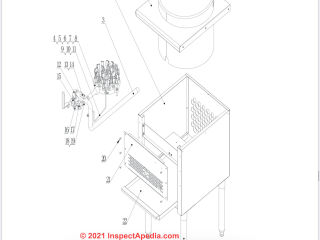
On 2020-07-04 - by (mod) -
I would contact the manufacturer directly to be sure of getting exactly the right size of orifice of gas jets or spuds.
On 2020-07-04 by Anonymous
Please spuds for mgr7662ww2
On 2019-12-08 - by (mod) -
Walt larger openings will go on larger burners, but for your SPECIFIC appliance the instructions will give you a table specifying exactly which orifice goes where; don't ignore that or your appliance may be unsafe.
On 2019-12-07 by walt
spuds #93 #100 #108 go where or larger the # the bigger the burner top ?
On 2019-05-14 by (mod) - convert Samsung stove from LP back to Natural Gas
Sure Vera
Most-likely if you can find the installation manual for your Samsung stove the instructions there will discuss fuel conversion and should give the proper orifice numbers; but gee surely you can find a local Samsung dealer who can intervene for you, contact the company, and extract the proper change-over parts for your stove.
Is there any chance that the old parts were in fact left, perhaps tied to the back of your stove?
On 2019-05-13 by Vera
We had our Samsung stove (model NX58H5600SS) converted to LP when it was installed.
We have moved and now need to convert back. The installer did not leave the original parts, however. I've been trying to find a kit to go from LP back to natural gas and Samsung support has been useless. Any advice?
On 2017-10-12 by (mod) -
Keith, what I do is contact the manufacturer of the appliance I'm converting, that way I can be certain that not only the orifice is correct but also that the actual fitting will properly match its mounting location on the appliance.
On 2017-10-12 by Keith Wilson
Need natural gas orifices #55 #54 #43 . Where can I get them.
On 2017-04-12 by (mod) -
Moises
Not ALL appliances CAN be converted between fuels - that could be the trouble. If you call the company's technical support and ask that specific question that ought to help. If your tech support person seems dull, insist on speaking with a manager. There are life safety questions here.
On 2017-04-09 by Moises
,
Thanks for your response, They do not sell or give any info about the conversion, I was thinking to use a conversion kit from a Thor rangetop that matches the same BTU, the part number for this is LPK3618 U .
On 2017-04-09 by (mod) - DACOR rangetop DRT366S NG convert to LP
Moises
I would not assume that you can interchange gas orifices from one appliance into another. Doing so could be dangerous risking fire or explosion, or at the very least improper burner operation. Each appliance that I've installed and converted had its own unique orifice diameters and even fitting thread lengths and sizes. I'd contact DACOR to obtain the proper gas conversion kit.
Dacor
14425 Clark Avenue
City of Industry, CA 91745
Toll free: 800-793-0093
Main: 626-799-1000
Fax: 626-403-3130
Website: http://www.dacor.com/Customer-Care/Contact-Us
On 2017-04-09 by Moises
Hi, I have a DACOR rangetop DRT366S NG need to convert it to LP, but there is not available a lp kit ,
My question is if would be possible to interchange from a different brand of appliance with the same BTU? Please let me know.
On 2016-08-10 by (mod) -
Jerry,
Use the page bottom CONTACT link to send me photos.
Most gas regulators can be converted between LP and natural gas. BUT the heater also has to be set-up for the right fuel; usually there is a gas metering orifice right in the heater that must be the right one. If your heater previously worked then it's probably set for the right fuel.
But more important, before replacing any parts, let's diagnose what's wrong with the heater in the first place. Otherwise we risk wasting time and money fixing or changing the wrong parts.
Also watch out: a gas leak can blow up the trailer and you with it, and an improper gas flame can kill you with carbon monoxide.
On 2016-08-10 by Jerry Midler jfmidler@gmail.com
I have a old travel trailer water Heather that was not working so I went to Lowe's and pick up a Gas control valve/ Thermostat by Unitrol, same as the one that was on it, tell I look closer, and it said do not connect a L.P. gas water Heather to natural gas supply. Can I change it I've. Do I have to change it over.I can send photo of both of them. Thanks
On 2015-11-02 by (mod) -
Thanks so much Joe, glad this was helpful. Indeed it can come as a surprise that the manufacturer's instructions actually don't work - at least in the detail of installing a burner orifice through the smaller burners: the specified nut driver just didn't make it.
On 2015-11-01 by Joe
Great article. The Bosch directions did not account for removing the burner base but you gave me the confidence to do it.
...
Continue reading at CONVERT the BURNER VALVES or AIR SHUTTER or select a topic from the closely-related articles below, or see the complete ARTICLE INDEX.
Or see these
Recommended Articles
- GAS APPLIANCE CONVERT LP-to-NATURAL GAS
- TOOLS & SUPPLIES for GAS CONVERSION & COOKTOP INSTALLATION
- GAS APPLIANCE CONVERT REGULATOR NATURAL GAS-to-LP- from Natural to Propane Gas - separate article
- CONVERT the GAS ORIFICES or spuds - from Natural Gas to Propane
- CONVERT the BURNER VALVES or AIR SHUTTER - from Natural Gas to Propane
- GAS FLAME COLOR CHECK
- CONVERT OVEN BURNER & THERMOSTAT - from Natural Gas to Propane
- APPLIANCE COMPATABILITY to LPG, PROPANE vs NATURAL GAS
- TROUBLESHOOTING Q&A - Natural Gas to LP or Propane Gas Appliance Conversions
- GAS APPLIANCE OPERATION at HIGH ALTITUDE
- GAS BTUH, CUBIC FEET & ENERGY - calculate or convert between cubic feet of gas, liquid gallons of LP gas, and BTUs per cubic foot or gallon of gas fuels.
- GAS BURNER FLAME & NOISE DEFECTS
- GAS BURNER SOOT CAUSE & CURE
- GAS BURNER PILOT LIGHT PROCEDURE
- GAS COOKTOP INSTALLATION - into a countertop - piping connections, electrical connections, countertop preparation, countertop opening & clearances, testing for gas leaks, securing the cooktop to the countertop & final inspection & tests.
- GAS PRESSURES LP vs NATURAL GAS
- GAS REGULATORS & APPLIANCE / HEATER CONTROLS - adjustments needed when changing between LP-Propane & natural gas or for tall buildings or high altitude
- GAS REGULATORS for LP TANKS
Suggested citation for this web page
CONVERT the GAS ORIFICES at InspectApedia.com - online encyclopedia of building & environmental inspection, testing, diagnosis, repair, & problem prevention advice.
Or see this
INDEX to RELATED ARTICLES: ARTICLE INDEX to GAS APPLIANCES, PIPING, CONTROLS
Or use the SEARCH BOX found below to Ask a Question or Search InspectApedia
Ask a Question or Search InspectApedia
Questions & answers or comments about gas fuel conversions: LP or "bottled gas" to piped-in natural gas service.
Try the search box just below, or if you prefer, post a question or comment in the Comments box below and we will respond promptly.
Search the InspectApedia website
Note: appearance of your Comment below may be delayed: if your comment contains an image, photograph, web link, or text that looks to the software as if it might be a web link, your posting will appear after it has been approved by a moderator. Apologies for the delay.
Only one image can be added per comment but you can post as many comments, and therefore images, as you like.
You will not receive a notification when a response to your question has been posted.
Please bookmark this page to make it easy for you to check back for our response.
IF above you see "Comment Form is loading comments..." then COMMENT BOX - countable.ca / bawkbox.com IS NOT WORKING.
In any case you are welcome to send an email directly to us at InspectApedia.com at editor@inspectApedia.com
We'll reply to you directly. Please help us help you by noting, in your email, the URL of the InspectApedia page where you wanted to comment.
Citations & References
In addition to any citations in the article above, a full list is available on request.
- Bosch, "Gas Cooktops Installation Manual, NGM Gas Cooktops (NGM30, NGM50, NGM 56, NGM80, NGM86, NGMP65)", (2013), Bosch, 1901 Main St., Suite 600, Irvine CA 92614, Tel: 800-944-2904, Website: www.bosch-home.com
- Bosch, "LP Gas Conversion Kit Installation Manual , NGM Gas Cooktops (NGM30, NGM50, NGM 56, NGM80, NGM86, NGMP65)", (2014), Bosch, 1901 Main St., Suite 600, Irvine CA 92614, Tel: 800-944-2904, Website: www.bosch-home.com
- Bosch, "Gas Cooktops Use and Care Manual, NGM5055, NGM8055, NGM8065, NGMPO55, NGM5655, NGM8655, NGM8665, NGMP655", (11/13), Bosch, 1901 Main St., Suite 600, Irvine CA 92614, Tel: 800-944-2904, Website: www.bosch-home.com
- Venera Brinzea, Maria Mitu, Codina Movileanu, Adina Musuc and Domnina Razus, "Expansion Coefficients And Normal Burning Velocities Of Propane-air Mixtures By The Closed Vessel Technique", University of Bucharrest, (2010), Analele Universatati Bucuresti, Department of Physical Chemistry 4-12 Regina Elisabeta Blvd, District 3, Bucharest phone: +40'21'3143508; fax: +40-21-3159249 p ISSN: 1220-871X e ISSN: 1844-0401, ARS DOCENDI PUBLISHING HOUSE Sos. Panduri 90, District 5 Bucharest phone/fax: +40'21'4102575 e'mail: arsdocendi@yahoo.com
- Whirlpool Corporation, "Propane Conversion Kit Safety", retrieved 4/28/14, original source: http://www.whirlpoolcomfort.com/Upload/20562901.pdf
- PropaneCarbs.com, "Tri Fuel Natural Gas & Propane Conversion Kits, More Information About Conversion Kits ... for Generators, Welders, Concrete Sws, Floor Cleaners, Man Lifts", Tel: 1-877-425-8383, Email: info@propanecarbs.com, Website: http://www.propanecarbs.com, retrieed 4/28/14, original source: http://www.propanecarbs.com/tri_fuel_kits.html
- Propane101.com, "Converting Gas Appliances", Email: webmaster@propane101.com, website: http://www.propane101.com, retrieved 4/28/2014, original source: http://www.propane101.com/lpgasapplianceconversions.htm
Notice: as of the retrieval date, and regarding authority, the "Propane 101" website does not name authors, provides no contact information, no address. - Rheem Corporation, "Conversion Instructions, Natural Gas to LP Gas", FaxBack 1506 These fuel conversion instructions are limited to Manufactured Housing products only. Retrived 4/28/14, original source: http://www.rheem.com/docs /FetchDocument.aspx?ID=1c3868ba-1cdc-4e3f-8aec-b7c7a4a1d137
- U.S. Energy Information Administration - eia.doe.gov/
- U.S. Environmental Protection Agency - epa.gov/solar/energy-and-you/affect/natural-gas.html
- At Natural Gas.Org www.naturalgas.org/environment/naturalgas.asp#emission you’ll find a table of combustion products
- At geocities.com/rainforest/6847/report1.html is an interesting and detailed though not “neutral” report on the components and contaminants in the combustion of natural gas. You’ll see a long long list of emissions products, but look again – most of the contaminant levels listed are in the picograms.
- apvgn.pt/documentacao/iangv_rep_part1.pdf lists the components in natural gas exhaust from vehicles
- The Need Project, Manassas, VA: need.org/needpdf/infobook_activities/SecInfo/NGasS.pdf
- Kroschwitz, Jacqueline I., and Mary Howe-Grant (eds.). "Gas, Natural." In Encyclopedia of Chemical Technology. 4th ed., vol. 12. New York: John Wiley and Sons, Inc., 1993.
- Tussing, Arlon R., & Bob Tippee. The Natural Gas Industry: Evolution, Structure, and Economics. 2nd ed. Tulsa, OK: PennWell Publishing, 1995.
- Thanks to reader E Leal for suggesting the addition of details about how to convert gas burning appliances from propane to natural gas or from natural gas to propane. 8/4/09
- Thanks to reader JR for discussing LP and natural gas operating pressures and leak detection safety, October 2010.
- Glenwood Range Company, Customer Service, 435 Park Ave., Delaware OH 43105, 614-363-1381, Glenwood-Sunray Service Center: 215-682-4211.
- Carbon Monoxide Gas Toxicity, exposure limits, poisoning symptoms, and inspecting buildings for CO hazards
- HOT WATER HEATERS - a detailed guide to all types of hot water sources, problems, inspection, repair
- SEWER GAS ODORS in COLD / WET WEATHER - Septic Odors or Sewage Odor Diagnosis & Repair Guide for diagnosing and eliminating cold weather sewer gas odors
- Water Pressure Loss - Diagnosis how to determine why water pressure has been lost or why there is no water at all in a building
- In addition to citations & references found in this article, see the research citations given at the end of the related articles found at our suggested
CONTINUE READING or RECOMMENDED ARTICLES.
- Carson, Dunlop & Associates Ltd., 120 Carlton Street Suite 407, Toronto ON M5A 4K2. Tel: (416) 964-9415 1-800-268-7070 Email: info@carsondunlop.com. Alan Carson is a past president of ASHI, the American Society of Home Inspectors.
Thanks to Alan Carson and Bob Dunlop, for permission for InspectAPedia to use text excerpts from The HOME REFERENCE BOOK - the Encyclopedia of Homes and to use illustrations from The ILLUSTRATED HOME .
Carson Dunlop Associates provides extensive home inspection education and report writing material. In gratitude we provide links to tsome Carson Dunlop Associates products and services.


